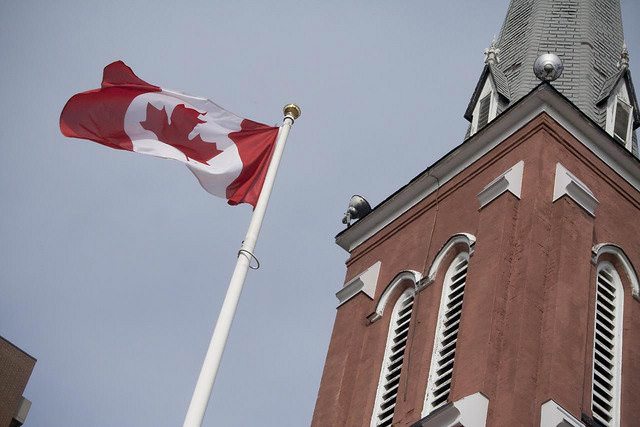Where We’ve Been, Where We Can Go From Here
150 years ago, Canada was a Christian nation. On July 1, 1867, the newest country in the world rejoiced in the title “Dominion” and took as its motto “A Mari Usque Ad Mare,” (From Sea to Sea), terms plucked from Psalm 72. Religion infused politics, culture and everyday life; it guided one’s vote, one’s choice of spouse, and place of education. To be a respectable citizen, one had to be a church-goer.
The last half of the 19th Century saw Canadian Christianity fuel a drive for social and spiritual reform; churches founded schools and training centres, hospitals, asylums, seniors’ homes and orphanages. Many of the country’s universities were established by religious denominations—McMaster, for example, sprang from the Baptists, Laval from the Roman Catholics, and Western from Anglican roots. Christians provided most of the nation’s social safety net: they battled prostitution, domestic violence, drunkenness, and tried to enforce the Sabbath as a day of rest.
The capital of Ontario was known as “Toronto the Good”, a place where streetcars did not run on Sunday, and where the mayor flew a banner reading “Except the Lord Build the City, the Watchman Wakes but in Vain.” In the opinion of the principal of Queen’s University (a Presbyterian foundation), “Church-going habits are universal. Family worship is generally observed. Family life is pure”.
When Canada entered the Great War in 1914, many of the hundreds of thousands of volunteers were motivated by their Christian faith and felt that their enlistment was serving God. Newspapers, monuments, and poets equated their battlefield deaths with that of Jesus on the cross. They died, said one writer, as “joint heirs with Christ because they bled to save His loved ones.” (On the other hand, the Catholic Church in Quebec lent its considerable support to anti-war and anti-conscription efforts).
Though the horrors of trench warfare coupled with compulsory church attendance seemed to have disillusioned many veterans, religious enthusiasm in the postwar years continued, often finding its outlet in politics. The push for the prohibition of alcohol sales was led by the Women’s Christian Temperance Union while the new socialist party, the Cooperative Commonwealth Federation (the CCF, forerunner of today’s NDP), found leaders in Methodist minister J.S. Woodworth, Baptist preacher Tommy Douglas, and Stanley Knowles of the United Church. During the Great Depression of the 1930s, the voters of Alberta turned to the Social Credit Party, led by radio evangelist “Bible Bill” Aberhart, founder of the Calgary Prophetic Bible Institute.
Unlike the aftermath of the First World War, the end of the second global conflict in 1945 signalled a rise in the fortunes of Canadian Christianity. Veterans who flocked home to build their families overwhelmingly took them to church. A Gallup poll of the time reported that 67 per cent of Canadians had attended a worship service in the past week (in Quebec the figure was an astonishing 90 per cent). As the active loins of the nation produced the Baby Boom, the biggest generational cohort in human history, Sunday School classes were jam-packed. From 1945 to 1965 the United Church of Canada built 1,500 new churches. Evangelistic crusades, led by Billy Graham or Canadians like Charles Templeton and Leighton Ford, were well attended, while on TV viewers saw overtly Christian programs like Bishop Fulton J. Sheen’s Life is Worth Living or the Lutheran This Is the Life. Membership in mainline Protestant denominations reached a peak in the 1960s—but then the wheels fell off the Christian bandwagon. Canadians started abandoning their churches in increasingly greater numbers, a trend that has not stopped in the 21st century.
What happened in the 1960s to provoke the decline of Canadian Christianity? Historians and sociologists can point to any number of reasons.
The secularisation theory holds that as societies grow increasingly modern, urban, and industrial they will abandon religion; the European experience since the 1940’s may well bear that out as churchgoing Christians on that continent are now a minority of the population.
Others point to the adoption of new liberal theology. A study commissioned for Anglican Church in 1965 claimed that society had left the churches behind: they were boring, tired and wed to the status quo. The future lay in social action, the embrace of science, and a moral relativism. Doctrine was no longer important, said The Comfortable Pew; tolerance and being “relevant” were what mattered. The clergy of the major Protestant denominations agreed and new church curricula were adopted that challenged old truth claims and abandoned the importance of evangelisation in favour of social reform. Baby Boomers of those churches heard the siren call of sex, drugs and rock ‘n roll and began to leave the churches that frowned on such a lifestyle. The Catholic Church (particularly in Quebec) suffered from being viewed as rural and paternalistic and its believers were challenged by the Vatican’s ban on artificial contraception that was stated so definitively in the decree Humanae Vitae in 1968. Though most Catholics continued to still claim to be members, attendance at masses dropped sharply and the numbers of young people who chose to be priests or nuns almost evaporated. Only in some conservative Protestant churches did the decline not occur.
A few numbers should illustrate the plight of Christianity in the 21st Century. In the 1991 census, 83 per cent of Canadians identified themselves as Christian; that number was 77 per cent in 2001; in 2011, it was 67 per cent. Over that 20-year span the United Church of Canada lost a million members while the Anglicans shrank from 2.1 million to 1.6 million. Mainline Protestants in 1991 made up 25 per cent of the population; in 2011 that was 14 per cent. The 3.4 million claiming no religion in 1991 grew to 7.8 million in 2001, almost a quarter of the nation’s inhabitants. Muslims outnumber the combined total of Presbyterians and Lutherans. Conservative and evangelical denominations, however, increased their membership from 353,000 to 960,00—good news, but it represents only 3 per cent of the population. Inasmuch as the membership of the mainline denominations is an aging one (the average United Church member is 65), we can anticipate no halt to the decline of the numbers of Canadians professing the religion of Jesus. Those of you reading this magazine can expect to be part of a minority sect for the rest of your life.
What is the future of Canadian Christianity? There is some good news. Christianity is doing exceedingly well outside of North American and Europe and we can look to many of the immigrants from Africa, Asia, and South America to be enthusiastic believers. We will also find that as there is little social incentive to be a Christian, the quality of genuine adherents will rise. Perhaps our future will be like the situation described by Greta Garbo in the 1939 movie Ninotchka where she plays a grim Soviet commissar visiting Paris. When asked how things are back in the USSR, she replies that the latest purges have been a great success and that there are now going to be “fewer but better Russians.”
About


